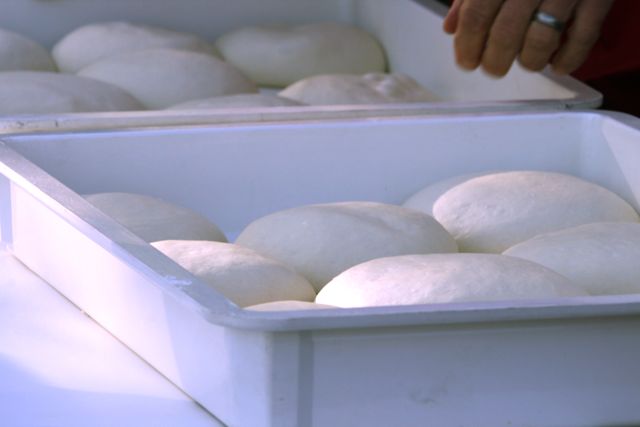Classic Pizza Dough, Neo-Neapolitan-Style
Classic Pizza Dough, Neo-Neapolitan Style
(Makes five 8-ounce pizzas)
What makes this Neo-Neapolitan is that I use American bread flour instead of Italian -00- flour, but you can certainly use Italian flour, such as Caputo, if you want to make an authentic Napoletana dough. Just cut back on the water by about 2 ounces, since Italian flour does not absorb as much as the higher protein American flour. Always use unbleached flour for better flavor but, if you only have bleached flour it will still work even if it doesn’t taste quite as good. If you want to make it more like a New Haven-style dough (or like Totonno’s or other coal-oven pizzerias), add 1 tablespoon of sugar or honey and 2 tablespoons of olive oil. These are optional–the dough is great with or without them. As with the Country Dough, the key is to make it wet enough so that the cornicione (the edge or crown) really puffs in the oven.

Neo-Neopalitan dough in proofing trays
5 1/4 cups (24 ounces by weight) unbleached bread flour
2 teaspoons (0.5 oz.) kosher salt
1 1/4 teaspoons (0.14 oz.) instant yeast (or 1 1/2 teaspoons active dry yeast dissolved in the water)
2 tablespoons (1 oz.) olive oil (optional)
1 tablespoons (1/2 oz.) sugar or honey (optional)
2 1/4 cups (18 oz.) room temperature water (less if using honey or oil)
–You can mix this by hand with a big spoon or in an electric mixer using the paddle (not the dough hook).
–Combine all the ingredients in the bowl and mix for one minute, to form a coarse, sticky dough ball.
–Let the dough rest for five minutes, then mix again for one minute to make a smooth, very tacky ball of dough.
–Transfer the dough to a lightly oiled work surface, rub a little oil on your hands, and fold the dough into a smooth ball. Let it rest on the work surface for 5 minutes and then stretch and fold the dough into a tight ball. Repeat this again, two more times, at 5 minute intervals. Place the dough in a lightly oiled bowl, cover with plastic wrap, and immediately place in the refrigerator. The dough can be used anywhere from 6 hours to three days after it goes in the fridge.
— (Note: the following steps are the same as for the Country Pizza Dough:) When ready to make the pizzas, pull the dough from the refrigerator two hours prior to when you plan to bake. Divide the dough into five 8-ounce pieces (if there is any extra dough divide it evenly among the dough balls). With either oil or flour on your hands, form each piece into a tight dough ball and place on a lightly oiled pan. Mist the dough balls with spray oil and cover loosely with plastic wrap or place the pan inside a large plastic bag. Give the dough at least 90 minutes before making the pizzas. If you don’t plan to use them all, place the extra dough balls inside of an oiled freezer bag and keep in the refrigerator (for up to three days) or in the freezer (for up to three months).
–If using a pizza stone in your home oven, preheat the oven to the highest setting
one hour before you plan to make the pizzas. If using a wood-fired oven, you know what to do for your particular oven. If you do not have a baking stone you can bake the pizzas on a sheet pan.
–Top with your favorite toppings–this dough can be stretched thin (12-13 inches) for Roman-style pizzas, or 10-11-inches for Naples-style.
Recent Articles by Peter Reinhart
- Pizza Quest: Chef Mike Friedman’s Pizza and Other Jewish Italian American Tributes in DC
- Pizza Quest: Animal-Free Cheese that Actually Tastes and Melts Like Cheese
- Pizza Quest, with Guests Jillana Miller and Ahmad Butler, aka Miller-Butler
- Pizza Quest: Shannon Mangini — Things Can Happen Fast
- Pizza Quest: Anthony Mangieri, with Big News About His New Line of Frozen Pizzas
- Pizza Quest: Author Ron Costello on The Hill (Where Both He and Peter Grew Up)
Add Comment
You must be logged in to post a comment.










Hi Peter,
How do you keep the bottom crust from being gummy? The moist toppings seem to inhibit rising of the bottom dough.
One trick is to put the cheese down first, in slices rather than shredded. This can create a moisture barrier and a surfing number of pizzerias use this rick. Another option that some pizza makers say works well is to brush the surface with olive oil (or even flavored oil) before applying the sauce. Again, it seems to act as a moisture barrier between the toppings and the dough. Please let us know if either of these approaches work for you.
For other Wood Fired Pizza Oven Owner’s… I find substituting 1 1/4 cups of Semolina flour helps the dough withstand the extreme temperatures of the oven. I also use honey *and* olive oil. This is my go-to recipe and it’s consistently a crowed pleaser.
Peter, wondering how this recipe could be adjusted for a quicker turn around? Don’t always have 8 hours notice before it’s pizza time!
The use of a preferment can shorten the fermentation time but, then again, you need to have one on hand, such as a sourdough starter. But even the use of an active, strong sponge can shorten fermentation times for a same day product. One final thought: keep some unused pizza dough in your freezer for use in such an situation, and then thaw and add it to your new dough (it has now become a type of preferment known as a pate ferment) to age and improve it for same day baking. Anywhere from 30%-50% old dough to new flour can make a huge difference in same day dough.